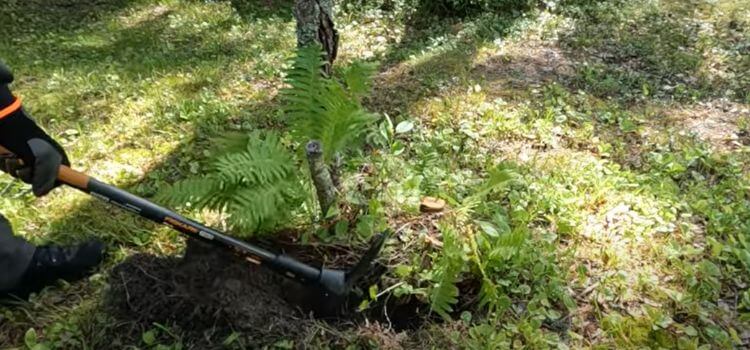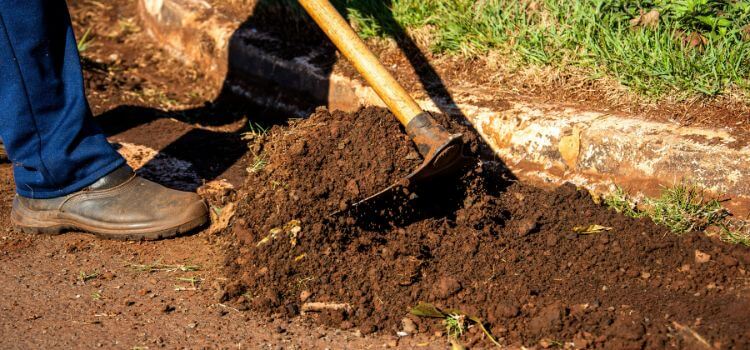As an Amazon Associate, I earn from qualifying purchases.
A grub hoe is ideal for breaking up soil and cutting roots, while a mattock is better for digging and chopping. Both tools are essential in gardening and landscaping.
Gardeners often debate whether to use a grub hoe or an axe. Each tool serves specific purposes that can make gardening tasks easier. A grub hoe features a broad, flat blade, perfect for slicing through tough soil and removing weeds.
On the other hand, an axe has a dual head, with one side for chopping and the other for digging. It’s versatile for breaking up hard ground and cutting through roots. Understanding the differences helps you select the right tool for your gardening needs. Both tools are durable and designed to handle heavy-duty tasks, making them invaluable for serious gardeners.
Grub Hoe
When choosing between a Grub Hoe and a Mattock, it’s essential to understand their unique features and uses. Both tools are valuable for gardening and landscaping but serve different purposes. This section will focus on the Grub Hoe, an indispensable tool for many gardeners.
What Is A Grub Hoe?
A Grub Hoe is a gardening tool with a heavy, flat blade at the end of a long handle. It’s primarily used to break up hard soil, dig trenches, and remove weeds. The blade is usually made of metal, providing the strength to penetrate tough ground.
Key characteristics of a Grub Hoe:
- Heavy blade for effective digging and chopping
- Long handle for leverage and ease of use
- Ideal for breaking up compacted soil
- Useful in weeding and trenching
Gardeners often choose a Grub Hoe for its efficiency in preparing the soil for planting. The flat blade allows for a broad reach, making it easier to cover large areas quickly. It’s beneficial in areas with clay or rocky soil.
Parts Of A Grub Hoe
The Grub Hoe consists of several essential parts that contribute to its effectiveness:
| Part | Description |
|---|---|
| Blade | A flat, heavy metal blade used for digging and chopping. |
| Handle | A long wooden or fiberglass handle for leverage and control. |
| Socket | The part where the blade attaches to the handle. |
| Ferrule | A metal ring that reinforces the connection between the blade and handle. |
The blade is the most crucial component, designed to withstand significant force. The handle provides the necessary leverage to apply this force efficiently. The socket and ferrule ensure a secure attachment, preventing the blade from detaching during use.
Types Of Grub Hoes
Grub Hoes come in various types, each suited for specific tasks:
- Standard Grub Hoe: A general-purpose tool with a wide blade for digging and weeding.
- Pointed Grub Hoe: Features a pointed blade for penetrating particularly hard or rocky soil.
- Heavy-Duty Grub Hoe: Built with a thicker blade for challenging tasks and tougher soils.
- Lightweight Grub Hoe: Designed for everyday gardening tasks, it is more accessible and easy to handle for extended use.
Each type of Grub Hoe serves a specific function, making it essential to choose the right one for your needs. A standard Grub Hoe is versatile and suitable for most tasks. A pointed Grub Hoe excels in breaking through hard surfaces, while a heavy-duty version handles the toughest jobs. A lightweight Grub Hoe is perfect for routine garden maintenance.
Uses Of A Grub Hoe
The Grub Hoe is a versatile tool with many uses in gardening and landscaping:
- Breaking Up Soil: The heavy blade is perfect for loosening compacted soil, making it easier to plant.
- Weeding: Use the flat blade to chop through weed roots, clearing large areas quickly.
- Trenching: Ideal for creating trenches for irrigation or planting rows of crops.
- Removing Sod: The blade can cut through sod, making it easier to remove for new planting areas.
- Shaping Garden Beds: Use the Grub Hoe to define and shape garden beds easily.
A Grub Hoe is essential for anyone involved in severe gardening or landscaping. Its ability to perform multiple tasks makes it valuable to any gardener’s toolkit.

Read Also: Stirrup Hoe Vs Dutch Hoe
Mattock
Grub Hoe and Mattock are essential tools for gardening and landscaping. Each has unique features suited for specific tasks. This post focuses on the Mattock, a versatile digging, chopping, and prying tool. Understanding the Mattock’s parts, types, and uses helps you choose the right tool for your gardening needs.
What Is A Mattock?
A Mattock is a robust hand tool for digging and chopping through tough soil and roots. It has a broad blade on one side and a pick or adze on the other. The design allows it to break up compacted soil, chop through roots, and loosen rocky ground, making it an essential tool for gardeners, landscapers, and farmers.
Key features of a Mattock include:
- Versatility: The dual-head design offers multiple functions in one tool.
- Durability: Made from high-quality steel, it withstands heavy use.
- Ergonomics: The handle is designed for comfortable grip and reduced strain.
A Mattock is a must-have for tough soil or root systems. Its robust construction and versatile design make it a reliable companion for various outdoor tasks.
Parts Of A Mattock
A Mattock consists of several vital components, each playing a crucial role in its functionality. Understanding these parts helps you choose the right Mattock for your needs.
Here are the main parts of a Mattock:
| Part | Description |
|---|---|
| Head | Made of steel, it has two working ends: a blade and a pick or adze. |
| Blade | Used for cutting through roots and soil. Broad and flat for effective chopping. |
| Pick/Adze | On the opposite side of the blade. The pick breaks rocks, and the adze digs. |
| Handle | Usually made of wood or fiberglass. Designed for a firm grip and control. |
Each part of the Mattock is designed to work together, providing a balanced and effective tool for various tasks.

Types Of Mattocks
There are different types of Mattocks, each suited to specific tasks. Knowing these types helps you select the right tool for your needs.
The main types of Mattocks include:
- Cutter Mattock: Features a broad blade on one side and an adze on the other. Ideal for cutting roots and digging.
- Pick Mattock: Has a pick on one side and an adze on the other. Best for breaking hard soil and rocks.
- Combination Mattock: Combines features of both Cutter and Pick Mattocks. Offers versatility for various tasks.
Each type of Mattock serves a unique purpose. The Cutter Mattock is great for gardening, while the Pick Mattock is perfect for rocky terrains. The Combination Mattock offers the best of both worlds.
Uses Of A Mattock
A Mattock is a versatile tool with many uses. Its design makes it suitable for a range of tasks in gardening and landscaping.
Typical uses of a Mattock include:
- Digging: The broad blade is perfect for digging holes and trenches.
- Chopping Roots: The sharp blade cuts through roots with ease.
- Breaking Soil: The pick end breaks up hard, compacted soil.
- Removing Stumps: Ideal for prying out small tree stumps.
- Weeding: Effective for removing large, stubborn weeds.
A Mattock is an indispensable tool for gardening, landscaping, or farming. Its robust design and multiple uses make it valuable to any tool collection.
Comparison
Understanding the Grub Hoe’s and Mattock’s unique features and functionalities is crucial for making an informed decision. Both tools are invaluable for gardening and landscaping but serve different purposes. This section delves into their design, efficiency, and versatility to help you choose the right tool.
Design And Construction
The Grub Hoe and Mattock have distinct designs tailored to their specific uses. The Grub Hoe features a wide, flat blade perpendicular to the handle. This design is ideal for breaking up hard soil and removing weeds. The blade is usually made of high-quality steel, ensuring durability and strength.
On the other hand, the Mattock has a dual-ended head. One side of the head is an axe blade, while the other is an adze. This combination makes the Mattock versatile for both cutting roots and digging. The handle of the Mattock is often made from wood or fibreglass, providing a sturdy grip.
Here’s a quick comparison table:
| Feature | Grub Hoe | Mattock |
|---|---|---|
| Blade Design | Wide, flat | Axe and adze |
| Material | Steel | Steel and wood/fiberglass |
| Handle | Wood/Fiberglass | Wood/Fiberglass |
Efficiency And Effectiveness
The efficiency of a gardening tool can significantly impact your workload. The Grub Hoe excels in breaking hard soil and uprooting weeds. Its wide blade covers more ground, allowing you to clear large areas quickly. The Grub Hoe is particularly effective in preparing garden beds and removing stubborn weeds.
In contrast, Mattock’s dual functionality makes it highly effective for different tasks. The axe blade side is excellent for chopping roots and small trees, while the adze side works well for digging and trenching. This dual-action head allows you to switch between tasks without changing tools, saving time and effort.
Both tools have their strengths:
- Grub Hoe: Best for breaking soil, uprooting weeds, and clearing large areas.
- Mattock: Great for chopping roots, digging trenches, and general versatility.
Versatility And Flexibility
The Mattock shines in its versatility. Its dual-ended head allows it to handle a variety of tasks, from chopping to digging. This flexibility makes it a valuable tool for gardeners and landscapers. You can use it to cut roots, dig trenches, and even shape the soil.
While less versatile than the Mattock, the Grub Hoe excels in specific tasks. It is beneficial for breaking up hard soil and removing weeds. If your primary goal is to prepare garden beds or clear large areas, the Grub Hoe is highly effective.
Critical points for versatility:
- Mattock: Multi-functional with axe and adze, suitable for various tasks.
- Grub Hoe: Specialized for soil preparation and weed removal.
In summary, both tools have their unique advantages. Your choice depends on your specific needs and tasks. Understanding their design, efficiency, and versatility will help you make the best decision.

Which One To Choose?
Choosing between a Grub Hoe and a Mattock can be challenging for gardeners and landscapers. Both tools are essential in breaking soil, digging, and other tasks. But which one should you choose for your project? Here, we’ll explore the factors to consider, personal preferences, and task suitability to help you make an informed decision.
Factors To Consider
When deciding between a Grub Hoe and a Mattock, several factors come into play:
- Weight: Grub Hoes are generally lighter, making them easier to handle for extended periods.
- Handle Length: A Grub Hoe often has an extended handle, providing better leverage for digging and chopping.
- Blade Shape: The blade of a Grub Hoe is typically broader and flatter, ideal for breaking up soil and removing weeds.
- Versatility: Mattocks have a pick on one side and an adze on the other, offering more functionality for different tasks.
Here’s a quick comparison:
| Factor | Grub Hoe | Mattock |
|---|---|---|
| Weight | Light | Heavy |
| Handle Length | Long | Short |
| Blade Shape | Flat | Pointed |
| Versatility | Low | High |
Personal Preferences
Your personal preferences play a significant role in choosing between a Grub Hoe and a Mattock. Consider the following:
- Comfort: A Grub Hoe’s lighter weight makes it more comfortable for prolonged use. If you prefer a tool that doesn’t strain your muscles, the Grub Hoe is ideal.
- Grip: The Grub Hoe’s more extended handle offers better grip and leverage. This might be your choice if you like more control over your tool.
- Multi-functionality: Mattocks are more versatile. They are perfect if you need a tool for digging and chopping roots.
- Task Frequency: If you frequently perform heavy-duty tasks, a Mattock’s durability and functionality could better serve you.
Think about how often you’ll use the tool and for what purposes. A Grub Hoe might be more suitable if your tasks are light and frequent. For heavy, infrequent tasks, a Mattock could be the better option.
Suitability For The Task
The suitability of either tool depends on the specific task you intend to perform:
- Breaking Soil: Both tools are excellent for breaking up soil, but the Grub Hoe excels in lighter, more frequent tasks.
- Digging: The Mattock is better for digging deeper holes and working with compacted soil.
- Weed Removal: The wide, flat blade of a Grub Hoe makes it ideal for removing weeds.
- Chopping Roots: The pointed end of the Mattock is perfect for chopping through tough roots.
Here’s a suitability summary:
| Task | Grub Hoe | Mattock |
|---|---|---|
| Breaking Soil | Excellent | Good |
| Digging | Good | Excellent |
| Weed Removal | Excellent | Good |
| Chopping Roots | Good | Excellent |
Consider the tasks you must complete and choose the tool that excels in those areas.
Frequently Asked Questions
A grub hoe is used to break up hard soil, remove weeds, and cultivate the ground. Its flat, sharpened blade is ideal for heavy-duty gardening tasks.
A grubbing mattock is a versatile hand tool for digging, chopping roots, and clearing ground. It features a horizontal adze blade and a vertical axe blade, which are ideal for heavy-duty landscaping tasks.
A mattock has a broad blade for digging and a pick for chopping. A Pulaski combines an axe and an adze for firefighting and trail work.
No, a grub hoe is not the same as a shovel. A grub hoe has a flat, broad blade for digging and chopping, while a shovel has a curved blade for scooping and lifting. They serve different purposes in gardening and landscaping.
A grub hoe is used for heavy-duty digging, soil breaking, and weed removal.
Conclusion
Choosing between a grub hoe and a mattock depends on your gardening needs. The grub hoe excels at breaking tough soil, while the mattock offers versatility for both digging and chopping. Evaluate your tasks and pick the right tool to enhance your gardening efficiency.
Happy gardening!

